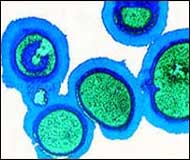
| |
| |
Content Reviewed 03/06/2008
|
|
 |
Healthcare Wide Hazards
MDRO - Multidrug-Resistant Organisms
|
Potential Hazard
 Exposure of employees to infections from multidrug resistant organisms such as "staph" and
"strep" bacteria in the workplace. Employees can become infected or become carriers and spread infection to other health
care workers
and patients.
To help stop the spread of MRSA in the
workplace, see: Exposure of employees to infections from multidrug resistant organisms such as "staph" and
"strep" bacteria in the workplace. Employees can become infected or become carriers and spread infection to other health
care workers
and patients.
To help stop the spread of MRSA in the
workplace, see:
-
Methicillin-resistant Staphylococcus aureus
(MRSA). Provides links with general information, answers specific
questions for employers and employees, and offers resources for a
variety of workplace settings, including healthcare, school, athletic,
and childcare.
The following information is provided by the
Centers for Disease Control and Prevention (CDC).
|
|
Multidrug-resistant organisms are bacteria and other microorganisms that have developed resistance to antimicrobial drugs. Common
examples of these organisms include:
-
MRSA - Methicillin/oxacillin-resistant Staphylococcus
aureus
- VRE - Vancomycin-resistant enterococci
- ESBLs - Extended-spectrum beta-lactamases (which are resistant to cephalosporins and monobactams)
- PRSP - Penicillin-resistant Streptococcus pneumoniae
- Multi-drug resistant Tuberculosis (MDR) TB is covered in HealthCare Wide Hazards
Tuberculosis.
What is colonization and infection?
- Colonization means that the organism is present in or on the body but is not causing illness. A hospital employee who has been
colonized can become a carrier and spread infection to other health care workers and patients.
- Infection means that the organism is present and is causing illness.
Risk factors for increasing the chance of both colonization and infection of these organisms include:
- Severity of illness
- Previous exposure to anti-microbial agents
- Underlying diseases or conditions, particularly:
- Chronic renal disease
- Insulin-dependent diabetes mellitus
- Peripheral vascular disease
- Dermatitis or skin lesions
- Invasive procedures, such as:
- Dialysis
- Presence of invasive devices
- Urinary catheterization
- Repeated contact with the health care system
- Previous colonization by a multi-drug-resistant organism
- Advanced age
Possible Solutions
- The CDC's recommendations for infection control in hospitals consist of
Standard Precautions, which should be used
for all patient care. In addition, the CDC recommends
Contact Precautions in special cases, when
the facility (based on national or local regulations) deems the multidrug-resistant microorganism to be of special clinical and
epidemiologic significance. For more information about the CDC's standard precautions:
Additional Information:
|
|
